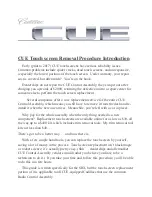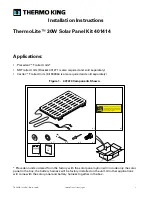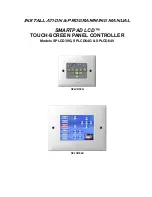
www.canadiansolar.com
| 7
· The recommended maximum series fuse rating is
stated in a table in the Annex.
· Modules should be safely fixed to bear all expected
loads, including wind and snow loads. A minimum
clearance of 6.5 mm (0.25 in) between modules
is required to allow for thermal expansion of the
frames.
· The small drainage holes on the underside of the
module must not be blocked.
OPTIMUM ORIENTATION AND TILT
· To maximize your annual yield, find out the opti
-
mum orientation and tilt for PV modules in your
region. The highest yields are achieved when sun-
light shines perpendicularly onto the PV modules.
AVOID SHADING
· Even minor partial shading (e.g. from dirt deposits)
reduces yields. A module can be considered to be
unshaded if its entire surface is free from shading
all year round. Sunlight should be able to reach the
module even on the shortest day of the year.
· Constant shading conditions can affect module
service lifetime, due to accelerated ageing of the
encapsulation material and thermal stress on the
bypass diodes.
RELIABLE VENTILATION
· Sufficient clearance (at least 10 cm
(3.94 in))
between the module frame and the mounting
surface is required to allow cooling air to circulate
around the back of the module. This also enables
condensation or moisture to dissipate.
5.1
MODULE WIRING
CORRECT WIRING SCHEME
· Ensure that the wiring is correct before starting up the
system. If the measured open circuit voltage (Voc) and
short-circuit current (Isc) differ substantially from the
specifications, this indicates that there is a wiring fault.
· When modules have been pre-installed but the system
has not been connected to the grid yet, each module
string should be kept under open-circuit conditions
and proper actions should be taken to avoid dust and
moisture penetration inside the connectors.
CORRECT CONNECTION OF PLUG CONNECTORS
· Make sure that connections are safe and tight.
Plug connector should not be subjected to stress
from the exterior. Connectors should only be used
to connect the circuit. They should never be used
to turn the circuit on and off.
· Connectors are not waterproof when unmated.
When installing modules, connectors should be
connected to each other as soon as possible or
appropriate measures should be taken to avoid
moisture penetration.
USE OF SUITABLE MATERIALS
· Only use dedicated solar cable and suitable
connectors (wiring should be sheathed in a
sunlight-resistant conduit or, if exposed, should be
sunlight-resistant itself) that meet local fire, building
and electrical regulations. Please ensure that
all wiring is in perfect electrical and mechanical
condition.
· Installers may only use single conductor, 2.5-10
mm
2
(8-14 AWG), 90°C wet rated solar cable, with
proper insulation that is able to withstand the
maximum possible system open-circuit voltage (i.e.
TUV 2PfG1169 approved). Only copper conductor
material should be used. Select a suitable conduc-
tor gauge to minimize voltage drop.
CABLE AND CONNECTOR PROTECTION
· Secure the cables to the mounting system using
UV-resistant cable ties. Protect exposed cables
from damage by taking appropriate precautions
(e.g. placing them inside a plastic conduit). Avoid
exposure to direct sunlight.
· A minimum bending radius of 60 mm (2.36 in) is
required when securing the junction box cables to
the racking system.
· Do not place connectors in locations where water
could easily accumulate.





























